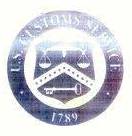
July/August 2009 Issue
TTAB Cases
In re Peter S. Herrick,
App. Ser. No. 76653159 (TTAB June 10, 2009)
ABSTRACT
The TTAB affirmed the Examining Attorney’s refusal to register the mark U.S. CUSTOMS SERVICE and Design for attorney services on the ground that the mark falsely suggested a connection with the governmental agency, the United States Border Protection, under Section 2(a). The TTAB also determined the mark was barred from registration under Section 2(b) because it constituted a simulation of the seal of the U.S. Treasury.
CASE SUMMARY
FACTS
Peter S. Herrick (“Applicant”) applied to register the mark U.S. CUSTOMS SERVICE and Design, shown below, for “attorney services,” in Class 42.

Among other grounds, the Examining Attorney refused registration (1) under Section 2(a) on the ground that the mark falsely suggested a connection with the United States Border Protection, formerly known as the United States Customs Service, an agency of the U.S. government; and (2) under Section 2(b) on the ground that the mark consisted of or comprised a simulation of an insignia of the United States, namely, the insignia of the U.S. Customs Service and/or the U.S. Treasury.
ANALYSIS
The TTAB noted that Section 2(a) refers to a false suggestion of a connection with a person or institution, and that an “institution” as used in Section 2(a) includes government agencies. The TTAB then applied the four-part test to determine whether a false suggestion of a connection had been established, namely, whether (1) the mark is the same as, or a close approximation of, the name of or identity previously used by another person; (2) the mark would be recognized as such because it points uniquely and unmistakably to that person; (3) the person named by the mark is not connected with the activities performed by the applicant under the mark; and (4) the prior user’s name or identity is of sufficient fame or reputation that a connection with such person would be presumed when applicant’s mark is used on applicant’s goods. The TTAB determined that the test had been met.
The TTAB rejected Applicant’s argument that the Examining Attorney had not established element one because the U.S. Customs Service is no longer in existence, having merged into the Department of Homeland Security in 2003 and commenced operations as United States Customs and Border Protection (“CBP”). The TTAB explained that CBP still refers to itself as the U.S. Customs Service, as do members of the public. Further, the U.S. Customs Service had previously used a seal that is virtually identical to Applicant’s mark. Accordingly, the TTAB found that Applicant’s mark was a close approximation of the former name and/or current identity of CBP.
The TTAB also dismissed Applicant’s argument that Applicant’s mark did not point uniquely and unmistakably to the U.S. Customs Service because the agency was no longer operational under that name. The TTAB noted that Applicant’s use of the former U.S. Customs Service seal in connection with its legal services relating to U.S. customs law was strong evidence that Applicant was attempting to draw a connection between its services and the agency’s services. Further, the TTAB found that the name “U.S. Customs Service” had meaning only as a governmental agency, and thus Applicant’s mark pointed uniquely and unmistakably to CBP.
The TTAB noted that CBP had no connection with Applicant’s business and Applicant had not claimed that it was part of the agency.
Finally, the TTAB agreed with the Examining Attorney that the U.S. Customs Service’s name or reputation was sufficiently famous that a connection with the CBP would be presumed by the use of Applicant’s mark. The TTAB explained that Applicant’s “attorney services” were broad enough to encompass customs work and its services relating to U.S. customs law were closely related to the activities performed by CBP. Further, based on Applicant’s use of a virtually identical seal to the one previously used by the U.S. Customs Service, the TTAB inferred that Applicant intended to create a connection with the CBP. Accordingly, the TTAB concluded that the four-part test had been satisfied, and affirmed the TTAB’s refusal under Section 2(a).
Turning to the Section 2(b) refusal, the TTAB noted that the relevant test was whether the applied-for mark “identif[ied] people and things associated with a particular agency within a department of the executive branch of the government, rather than functioned as an insignia of national significance representing the authority of the government or nation as a whole.” In this case, the Examining Attorney had refused registration on the ground that Applicant’s mark was a simulation of the Department of Treasury seal. The TTAB found that the seal of the Department of Treasury did represent the “authority of the government,” and thus the simulation of that seal by Applicant was prohibited under Section 2(b).CONCLUSION
Although the name of an institution may change, a mark that is a close approximation of the institution’s former name may be refused registration under Section 2(a) if the public still associates the former name with the institution.